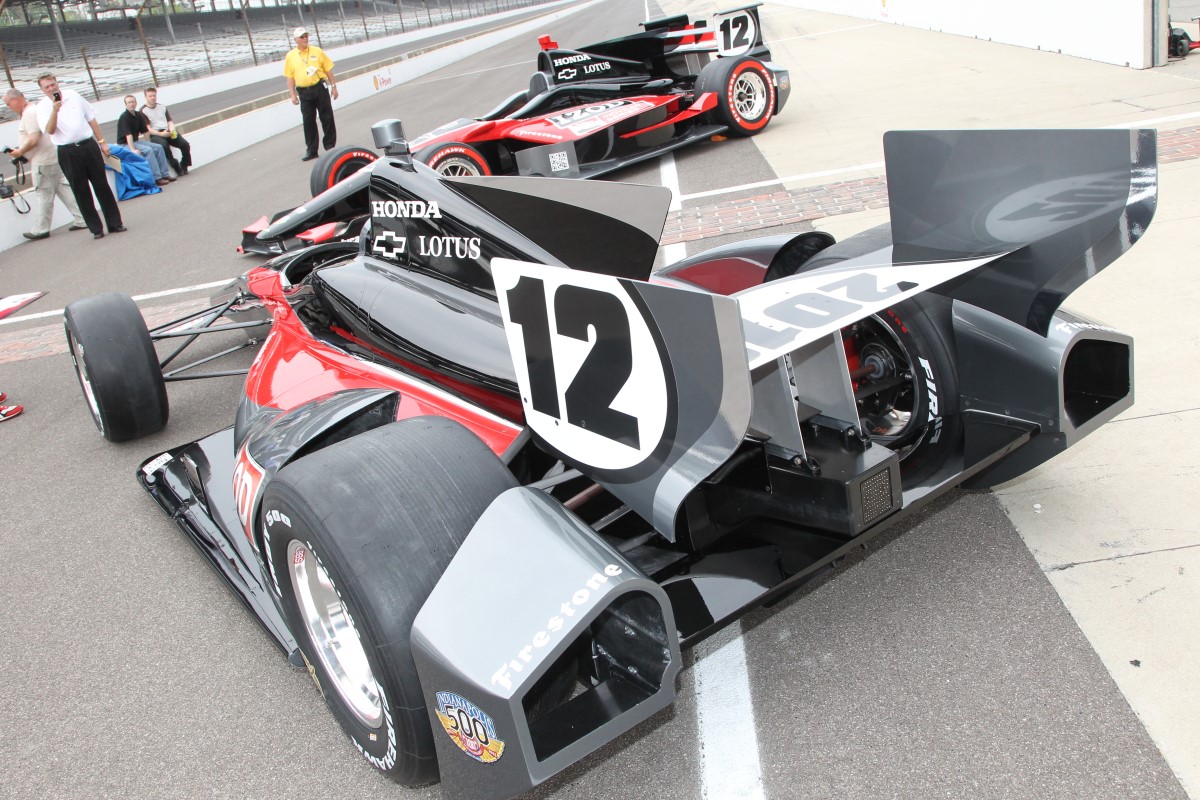Divergent 2012 IndyCar concepts match schedule
 It's sleek, has a familiar front end and even has a fin that reminds some of the 1956 Novi. The 2012 IZOD IndyCar Series oval concept car and its companion road/street course model were unveiled May 10 for the public to digest what it might see soon on the series' diverse set of racetracks.
It's sleek, has a familiar front end and even has a fin that reminds some of the 1956 Novi. The 2012 IZOD IndyCar Series oval concept car and its companion road/street course model were unveiled May 10 for the public to digest what it might see soon on the series' diverse set of racetracks.
The mockups, exactly what 2012 car project manager Tony Cotman wanted to display, will be in the Pagoda Plaza at the Indianapolis Motor Speedway through the 100th anniversary Indianapolis 500 on May 29.
A rolling chassis – dubbed the IndyCar Safety Cell – will be the universal feature of the next generation car, with bodywork open to development and sale by any approved manufacturer. Three engine companies – Honda, Chevrolet and Lotus — committed for 2012 will augment the IndyCar Safety Cell and aero kit programs, creating its own buzz.
"The idea behind these is to show two totally different-looking vehicles that underneath are the same chassis," Cotman said. "There is a lot of room for aerodynamic kit development and that's what this platform is about – allowing people the freedom to design as they wish, dream as they wish and come up with a superior product than others. That's what drives competition.
"So will these be exactly what Dallara's kits are going to look like on road courses and ovals next year? No."
Dallara Automobili's aero components for the prototype car that is scheduled to undergo initial testing the first week of August are currently being finalized through wind tunnel testing at the company's headquarters in Parma, Italy.
"The display cars are mockups of some of the things we could be doing on these cars," said Sam Garrett, Dallara's U.S.-based quality control leader who returned this past weekend from Italy. "We have a plan and it's all coming together. About 95 percent of the parts of the car are in production, and we'll be assembling the prototype car shortly. By August, we'll already have to be into the production run for the first 30 or 40 cars of parts."
The public will note the differentiation in bodywork on the variety of racetracks, though Garrett said the company is "really proud" that there will be cost savings to teams beyond the initial chassis purchase price of $349,000 (which includes everything but the seat and steering wheel), such as one set of suspension.
"Our current car there is a road course suspension and completely separate oval suspension – uprights, wishbones, brakes, everything," Garrett said. "On the new car, the package is the same. You need to make a change to the left-side camber between the two, but that's it. Teams will have to do a lot of setup work and maybe tweak some of the aero stuff, and maybe some of the things used on road courses won't be used on ovals, but it's a much easier transition.
"And they'll have less inventory. We embraced that not only are we going to make the car less expensive to buy but also less expensive to maintain. With only one set of suspension and uprights, that's a lot less spares that you have to carry, and the spares you do have on the truck will be applicable at every race."
After presenting its rolling chassis concept and business model, Dallara Automobili was recommended last July by the seven-member ICONIC Committee to design and produce the 2012 car that includes the attributes of safety, raceability, cost-effectiveness, efficiency, relevant technology, American-made, green and modern looking.
Construction of Dallara's U.S. headquarters will begin in the next week on Main Street in Speedway, Ind. – a few hundred yards from the Indianapolis Motor Speedway. In the meantime, company personnel will assemble the chassis and work out of a temporary home across the street.
"We've spent a lot of time trying to incorporate all the elements the ICONIC Committee asked for – safety, lower cost, something that looks unique," Garrett added. "Our time has been focused on making the car safe and stable so that it is possible to put different bodywork styles on it to make it look unique.
"The current car (used in competition for the first time in 2003) has been a compromise. Even when it was an oval-only car there were three different types of tracks – the Speedway, which is unique; high-speed ovals and short ovals – and then you throw in road and street courses and you have a wide range of aerodynamics and mechanics of the car that you have to cover. So it's a continuous challenge to build one car to do it all. But we're on the way to seeing that for 2012."
